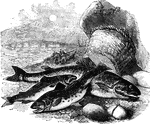
Flounder
"Is found at the mouths of nearly all European rivers, and is especially abundant where the bottom is…

Common Dab
"Is eight to ten inches long, feeds on crustacea, small fish, and marine insects, is often caught with…

Pole
"Is fifteen to twenty inches long; color yellowish-brown; found on the European coasts; rare in England."…

Halibut
"This is a large species, sometimes measuring seven or eight feet in length, and weighing five or six…
Herring
"It is twelve or thirteen inches long; feeds on various small fishes, including young herrings; spawns…

Pilchard
"Is eight to eleven inches long; it resembles the herring, but is smaller, and at the same time thicker."…
Sprat
"Is six inches long, and inferior to the herring in flavor; still immense numbers of it are taken along…

Whitebait
"A small fish, abundant in the River Thames, and greatly valued by the epicures of London. It is a common…
Anchovy
"A small silvery fish, four or five inches long; it is taken in vast numbers i nthe Mediterranean, where…

Twaite Shad
"Is twelve or thirteen inches in length, the flesh is dry and tasteless; nevertheless it is somewhat…

Salmon
"The salmon two to four feet long, and weighs ten to twelve pounds, though it has been taken of eights…

Parr
"Found in European waters, and being marked on the back by transverse dusky bars very similar to those…

Northern Charr
"A European species, and inhabits the northern lakes of England and those of Scotland; it is from one…

Grayling
"Found in the tivers of northern europe having rocky or gravelly bottoms. It resembles the trout in…

Gwyniad
"A lake fish of Northern Europe, ten to twelve inches long; it is gregarious, and approaches the shores…

Vendace
"Is a small fish, of delicate flavor, seven inches long, taken with nets in some fo the Scottish lakes."…
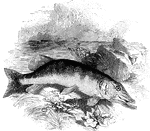
European Pike
"It is strong, fierce, and active, swims rapidly, and occasionally darts along with the swiftness of…
Pickerel
"Is from one to three feet long, and is found in most of the lakes, ponds, and rivers of the Middle…
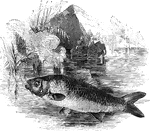
Carp
"They are distinguished by a small mouth and powerful teeth, though not set in the jaws. The body is…

Common Carp
"It is ten to forty inches long, and sometimes attains the weight of a hundred pounds; the general color…

Gold carp
"The Gold Carp, C. auratus, often called the Gold-fish and silver-fish, as it assumes both…

Barbel
"Said to be called so because of the barbs or wattles about its mouth; it is common in the warm and…

Gudgeon
"Common in Europe, and is found in streams which flow over gravelly soil. It swims in shoals, feeds…

Tench
"Found in most Europes lakes in rivers. It is exceedingly tenacious of life; loves foul and weedy water;…

Bream
"It is abundant in the larer lakes and quiet rivers of Great Britain and Ireland. It swims in shoals;…

Ide
"It feeds on worms and herbage, and the flesh is of good flavor. It is common in Northern Europe.

Roach
"The Roach, L. rutilus, is abundant in the rivers of the temperate parts of Europe. It attains…

Dace
"Feeds on worms and other soft substances; spawns in June; is six to nine inches long; is used as bait…

Graining
"Is found in the lakes and rivers of some parts of Europe; in its habits and food it resembles the trout,…

Chub
"Frequents deep places in the quiet parts of steams, sheltering itself usually under a bush or tree…

Redeye
"Is a very common fish in Europe; it is of brilliant colors, and very tenacious of life; it feeds on…

Blue Roach
"The Azurine or Blue Roach, L. ceruleus, is a small fish, seldom exceeding a pound in weight;…

Bleak
"The Bleak or Blick, L. alburnus, is a well-known, small species, inhabiting many of the rivers…
Loach
"It spawns in March or April, delights in small, shallow, clear streams, and has the habit of lurking…
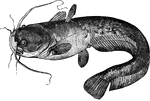
Sly Silurus
"It sometimes attains the length of six feet, and the weight of three hundred pounds. It is a slow and…
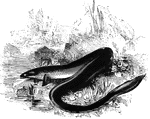
Common European Eel
"These have an elongated form, and a soft, thick, slimy skin; the scales are very minute, and imbedded…
Sharp-Nosed Eel
"It is from one to four feet long, and weighs from one to twenty-five pounds. This species feed on frogs…

Conger Eel
"It varies in length from three to ten feet, and in weight from five to one hundred and thirty pounds.…

Muraena
"A celebrated species, common in all parts of the Mediterranean, and occasionally met with on the coasts…
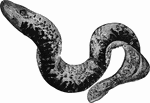
European lamprey
"The color is yellowish marked with brown. Like the sharks and rays is it without an air bladder; to…

Myxine
"The body is long and eel-like, and the skeleton is reduced to a mere cartilaginous tube. It ours out…

Cuttlefish
"The cuttlefishes have a strange method of walking, head-downward, on their outspread arms; they can…

Bone of the cuttle-fish
"An internal support of a calcareous nature, and formed in laminae; this is the well-known cuttlefish…
!["The Pen-Fish or Common Calamary, <em>L. vulgaris</em>, is the best-known species of the genus; the body is somewhat pellucid, of a greenish hue, changeable to dirty brown; the eyes are large and lustrous, of an emerald green, phosphoric, and fiery in a high degree. It is common in the european seas, and was known to the ancient Greeks and Romans. [Shown with a quill pen]" — Goodrich, 1859](https://etc.usf.edu/clipart/14000/14004/cmncalamari_14004_mth.gif)
Common calamari
"The Pen-Fish or Common Calamary, L. vulgaris, is the best-known species of the genus; the…
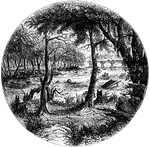
James River
"Scene on the James River, at Richmond. This view is from a long shaded island extending up the river…
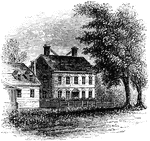
Nelson Mansion
"The Nelson Mansion. This view is from the street looking northwest. A long wooden building, with steep…
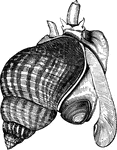
Common whelk
"Extensively caught in dredges in Europe, as it is eaten, and is also used as fish-bait. It is well-known…

Abdominal
"Pertaining to the abdomen or belly; situated in or on the abdomen: as abdominal ventral fins."-Wright,
Sagitta
"These are little fish-like animals furnished with one or two fin-like organs on the body and a broad…
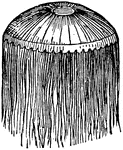
Acaleph
"One of the Acalephae; a name given to a large number of marine animals; and redpresenyted chiefly by…

Acanthoclinus
"(A fish that) had a compressed claviform body, posterior dorsal fins nearly opposite to the anus, prolonged…
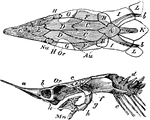
Sturgeon Skull
"Top and side views. The cartilaginous cranium shaded, is supposed to be seen through the unshded canial…
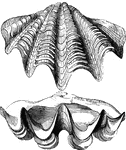
Shells of the great clam
"The Giant Clam, Tridacna gigas, is the largest of known shell-fish, the two valves sometimes…

Alewife
"A North American fish, Clupea Vernalis, from 8 to 10 inches long, resembling a small shad, but much…

Perch
"An embiotocoid fish, with small scales, uniserial and jaw teeth, and lip free and deeply cut along…
